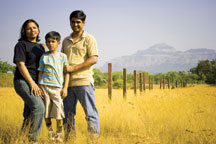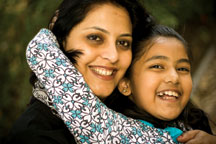Magazine
The Bilingual Dilemma

To speak or not speak? That's the question.
|
Many Indian parents are passionate about passing on their mother tongue to their children. How to manage that in a society where English is dominant is a common topic of discussion within the Indian community. And to confuse the issue further, there are some who are equally adamant about not teaching their mother tongue to their children. “Shouldn’t I spend time teaching my child English, which is, after all, going to be of greater utility in school and work?” is their line of reasoning. “Assuming that my children are going to live in the US, it would be better to focus on English than to teach a language that is going to be of limited use in this country.” It’s a fair point. But I happen to believe there are powerful benefits in passing one’s mother tongue to the next generation.
Take Arun and Veena Prasad, for instance. Their mother tongue is Kannada, which they have consistently spoken to their two daughters, Abhigna, age 8, and Agamya, age 4, since they were born. Both children speak primarily in English today, although both understand Kannada perfectly and Abhigna also speaks Kannada well. “Once Abhigna started going to kindergarten, English became her dominant language,” explains Veena. “Before that she spoke to us only in Kannada. And because Abhigna started speaking a lot of English, it was harder to maintain a Kannada only environment with Agamya. As a result, Agamya is not as fluent in Kannada.” Or take my Marathi sister-in-law Anu and her Telugu husband Sai Vemulakonda. They each decided to speak their mother tongue with their son Jaydev, who is 5 years old. He speaks both languages fluently and from a young age would converse in the appropriate language with each parent. He now speaks principally in English, although he still speaks Marathi and Telegu very well. Anu says: “TV exerts a big influence on him. He watches programs like Franklin Turtle which he relates to very well, and I think he likes to imitate the way Franklin speaks.” I’d seen these patterns before. Why do kids who speak their mother tongue fluently switch to English as their primary language? And why do the younger siblings less fluent in their mother tongue than their older brother or sister? How English Becomes the Primary Language Kendall King, associate professor of Linguistics at Georgetown University in Washington D.C. and co-author of The Bilingual Edge, says: “Children are incredibly sensitive to the social status of different languages. Once children enter pre-school, they are very quick to pick up that English is the language of most of what is cool in their environment – of Bob the Builder or of Hannah Montana,” or whatever else they find attractive. “Children are up against this tidal wave of English that just crashes around them on every side.” To give the mother tongue a chance, King suggests taking a “hot-house” approach. “Parents can set up a household system where that heritage language has the opportunity to develop and to grow in lots of different ways within the child.” It also allows “the child to develop comfort using it across a range of contexts before entering school.” The idea is to give the heritage language an advantage by ensuring that most of the communication in the home is conducted in that language. Meena Sridhar, professor of Asian and Asian American Studies and Linguistics at the State University of New York at Stony Brook, stresses that it is important for parents to speak the mother tongue. “Then the children will know this is our language, this is our mother’s language and our father’s language. If the parents speak in English and insist their children speak their mother tongue, it’s not going to happen.” But are there disadvantages? Some pre-school teachers advise parents not to teach children their mother tongue, because it interferes with their English language development.
I can relate somewhat to that advice. When my wife, Geetha Gopinath, and I agreed to create a hot-house environment to nurture Marathi for our daughter, Sathya, I was worried that it might impede her learning English. Predictably, with a Marathi-only environment, Sathya picked up Marathi as her first language and speaks it fluently. So far, so good. She’s 4 years old now and has been attending pre-school for nearly 7 months. This has represented her first prolonged contact with English. Although she is becoming increasingly comfortable with English every day, she’s not as fluent as her peers. But it thankfully doesn’t seem to bother her and she is getting better at expressing complex thoughts. In the first few weeks of her pre-school program, her teachers commented to us that, “Sathya is really shy and doesn’t talk in class.” Was that due to her lack of familiarity with English, I worried? In fact, on the day she uttered her first sentence in class, her classmate Kimberly exclaimed gleefully, “Look, Sathya can talk!” I was concerned about what we were putting Sathya through. She’s a very articulate child in Marathi, but were we limiting her ability to communicate outside the home? King provides perspective on this concern, noting: “What matters is less the number of vocabulary words that the child has at 4 1/2 than how many they have at 6 or 7 years. So I encourage parents to take a long-term view.” Sound advice in a society where we have come to expect instant results. Over the last couple of months, Sathya has made an exponential leap in her ability to speak English. Sridhar makes the point that in the development of a child here, “You don’t have to worry about teaching them English. It’s like an infection – they’ll get it.” I wish I could say I knew things would turn out this way. Starting out, I thought I knew better than Geetha and reasoned that we shouldn’t be too aggressive with the hot-house concept. After all, I grew up in Canada in a semi hot-house environment, while she grew up in India. What did she know about the rough and tumble of growing up as a minority in the West? But she stuck to her guns, and over my doubts I went along. I guess deep down, something told me we were doing the right thing. After all, Sathya was able to converse and connect with her great-grandmother and grandparents in India, because she speaks Marathi. I could see a rich bond grow between these elders and my daughter, which was comfort enough. Impact of Birth Order I have now begun to wonder about the fate of our second daughter, Keerthana. She’s just 15 months old and only utters a few simple words, but soon she’ll be speaking in full sentences. The literature suggests that younger siblings are less fluent in the heritage language. A couple of factors are at play, including the parental investment in their language development. Sridhar explains: “With the older child the parents spend much more time. This is the first child so they are constantly spending time with the child. When it comes to the second child, they are not spending as much time.” Another factor is that when the older child goes to school, it becomes harder to limit the extent of English spoken at home. “Typically that second child is starting to talk around the same time that the first child heads off to school. So you have a 2-year-old whose language is just starting to really bloom and a 4- or 5-year-old who is now spending large parts of her day in an English speaking environment,” King points out. To cope, she says, it is important to make the time parents spend with the younger child really language focused. Parents can use opportunities when the older child is away at pre-school to spend one-on-one intensive language time with the younger child. Another effective technique is setting up language rules at home. The head of one cross-cultural training company nurtured French as a second language in her home by insisting her children only speak French at dinnertime. We are anxious to discover whether Keerthana’s first language will be Marathi or English. If Geetha and I have our way, it’d be Marathi, but I think much of the decision rests in her older sister Sathya’s hands. Sathya responds when we encourage her to help teach Keerthana Marathi, but English frequently creeps into the conversations she has with Keerthana. So we have to stay vigilant. Mother Tongue and Identity
And I’m committed to staying vigilant, based on my own experience. Research points to the cognitive and academic advantages of being bilingual, no matter what the second language is. But there’s another powerful benefit that is relevant to our children growing up here – and that is in helping them develop a strong sense of identity, which can help lead to better self-esteem and self-confidence. Sridhar notes that Indian “children visit their relatives, but they can’t speak to them if they don’t speak English. Many of the older generation may not speak English. Then the children have nothing to talk about. So India is just a place where they go for their vacations. They don’t have a sense of belonging, because English doesn’t foster the kind of closeness” that a mother tongue does. As the youngest of three children who grew up in a semi hot-house environment in Canada, the research would have predicted that I wouldn’t be very fluent in my mother tongue. But I ended up learning Marathi reasonably well. I credit my grandparents, as well as my parents, who fostered my interaction with them as often as possible, even though we were oceans apart. People who meet me casually might classify me as an American Born Confused Desi (ABCD), but most people who know me well would scarcely call me confused. I think part of the reason is because I speak my mother tongue. Looking back, that helped to ground me in who I am, where I came from, and allowed me to develop relationships that expanded my understanding of the space that my family and my community occupy within the Indian diaspora. It is that sense of belonging I’d like to pass onto my daughters. To paraphrase a powerful line I heard the other day on National Public Radio: “English is important, no doubt, but your mother tongue is the language of love.” |



